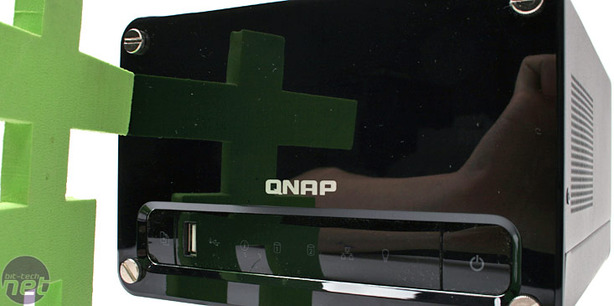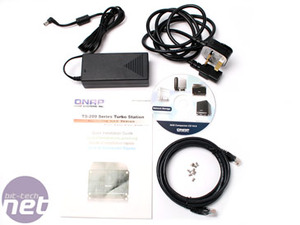
QNAP TS-209 Turbo NAS
Manufacturer: QNAPUK Price (as reviewed): £243.71 (inc. VAT)
US Price (as reviewed): $399.00 (ex. Tax)
Unless you're a digital hoarder who has more
Not everyone requires the storage space of a Google data centre, and a couple of drives, either just offering the total space or a mirror of each other for some peace of mind. Having the drives outside the main PC means there is no chance of them dying should the PSU pop, and leaving on a smaller, low power device is far more economical than leaving your big hunky PC running all day and night.
A two disk NAS box does limit the data storage options available though. With just a pair of drives, RAID 5 or 6 is unavailable, so data redundancy can only be achieved with RAID 1 but then you lose half your total capacity and achieve no extra performance. RAID 0 will give you the full capacity (with some overhead) and better performance but it will also double the risk of losing your data. JBOD is respectively safer for allowing the full capacity and "safer" than RAID 0, but it still has no data redundancy or extra performance.
The benefit of these simple RAID volumes though is that it's technically less taxing for the CPU than RAID arrays that feature parity. We found with the TS-409 Pro that the 500MHz Marvell CPU could barely keep up with a four disk RAID 5 array and caused the read/write performance to not be as high as we expected in quite a few scenarios.

The TS-209 II uses the same CPU and memory as the TS-409 Pro, but without the complicated RAID arrays. Because of this, we expect the TS-209's performance to be better than its four disk sibling. The other benefit of the TS-209 II is that it's half the price of the TS-409, while still offering the oodles of features we liked before. So let's get on and see how the TS-209 II shapes up...
Feature List
- Marvell 5281 500MHz SoC
- 256MB DDR2 DIMM
- Two 3.5" SATA I/II HDD
- One RJ45 Gigabit Ethernet socket
- Three USB 2.0 ports with support for USB printers, disk, digital camera, pen drive, card reader, USB hub, and USB UPS etc
- LED indicators for Status, USB, LAN, HDD 1, HDD 2
- File server
- FTP server
- Backup server
- Encrypted Remote Replication
- Web Server with Built-in phpMyAdmin: Joomla!
- MySQL Server
- Printer Server
- UPnP Media Server with DLNA and built-in TwonkyMedia Server
- iTunes Server
- Download Station - including BitTorrent (with DHT support) and eDonkey networks, FTP and HTTP downloads
- S.M.A.R.T & Advanced HDD Health Scanning (HHS)
- Comprehensive Event Log System
- Sharing files across Windows, Mac
- Secure data storage, access, and sharing (SHTML, SSL, SSH, Encrypted remote replication, IP filtering, secure FTP)
- Shared Folder Management
- One touch USB auto copy
- Web File Manager
- Network Recycle Bin
- Built-in Dynamic DNS support
The UPnP DLNA support is also very important for compatibility across the board with non-PC devices - products like HDTVs, set-top boxes, media centres, Xbox 360 and the Sony PS3 can see the NAS, its media and can play it back. Having said that though, there are some limitations in extension playback compatibility.
It does not feature an in-built switch but the three USB ports can be used to set up multiple printer servers running through the NAS, or alternatively they can be used for an extra level of backup to another USB disk or memory key with the one touch backup button, where specific folders or files can be backed up. QNAP also includes backup software - NetBak Replicator - for PCs connected to the TS-209 II they can backup instantly, on schedule, or set up an auto-sync for incremental backups. There is also support for popular third party software too: Acronis True Image, CA Brightstor ARCserver Backup, EMC Retrospect, Symantec Backup Exec.
The only other major feature worth pointing out is that Wordpress blogs or websites, in addition to the DynanicDNS service also support, can be run straight from the TS-209 II. It's very useful for serving large files from the hard drive (providing you have a good net connection) or are running a torrent server thanks to the embedded MySQL server and PHP support to distribute the bandwidth cost on your webhost. For the cost of hosting and a real domain though, we doubt you'd buy a whole £200 NAS to just serve a small website and for a large website the need for an ultra reliable net connection and managed server set up with redundancy to assure uptime is paramount.
In the box there is a power brick and mains lead, a CAT5 network cable, driver and information CD, some screws to secure the hard drives into the caddies, the front panel and TS-209 II leaflet. Everything you'd need is included, and you're not left to fish out your own screws or Ethernet cable. You may question why you need a disk for a networked device, but it is essential to run QNAP Finder and set up the NAS box in the first place, because until then you'll not have access to the web interface.

MSI MPG Velox 100R Chassis Review
October 14 2021 | 15:04










Want to comment? Please log in.